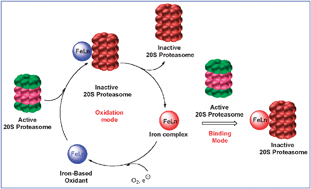Inhibition of the purified 20S proteasome by non-heme iron complexes
Abstract
Polypyridyl pentadentate

Maintenance work is planned for Wednesday 1st May 2024 from 9:00am to 11:00am (BST).
During this time, the performance of our website may be affected - searches may run slowly and some pages may be temporarily unavailable. If this happens, please try refreshing your web browser or try waiting two to three minutes before trying again.
We apologise for any inconvenience this might cause and thank you for your patience.
* Corresponding authors
a
Department of Chemistry, Wayne State University, Michigan 48202, Detroit, USA
E-mail:
jkodanko@chem.wayne.edu
Fax: +1 313-577-8822
Tel: +1 313-577-9043
b
Developmental Therapeutics Program, Barbara Ann Karmanos Cancer Institute, Departments of Oncology, Pharmacology and Pathology School of Medicine Wayne State University, MI 48201, Detroit, USA
E-mail:
doup@karmanos.org
Fax: +1 313-576-8307
Tel: +1 313-576-8301
Polypyridyl pentadentate

 Please wait while we load your content...
Something went wrong. Try again?
Please wait while we load your content...
Something went wrong. Try again?
 Fetching data from CrossRef.
Fetching data from CrossRef.
This may take some time to load.
Loading related content
